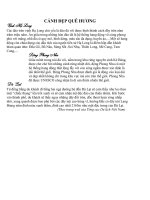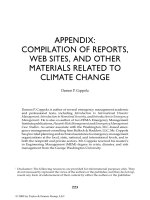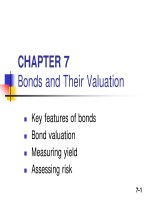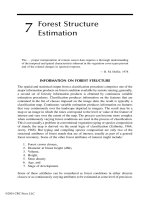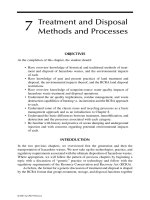Lecture multinational financial management chapter 7 ngo thi ngoc huyen
Bạn đang xem bản rút gọn của tài liệu. Xem và tải ngay bản đầy đủ của tài liệu tại đây (719.62 KB, 12 trang )
FOREIGN CURRENCY OPTIONS
CHAPTER
SEVEND
• A foreign currency option is a contract giving the purchaser
of the option the right to buy or sell a given amount of
currency at a fixed price per unit for a specified time period
FOREIGN CURRENCY
OPTIONS
– The most important part of clause is the “right, but not the
obligation” to take an action
– Two basic types of options, calls and puts
• Call – buyer has right to purchase currency
• Put – buyer has right to sell currency
– The buyer of the option is the holder and the seller of the option is
termed the writer
1
CHAPTER OVERVIEW
3
FOREIGN CURRENCY OPTIONS MARKETS
• Introduction
Table shows option prices on British pound taken from the online edition of
Wall Street Journal on Friday, January 31, 2007
BRITISH POUND (CME)
62,500 pounds; cents per pound
Strike
Calls
Price
Feb
Mar
162
2.36
2.94
163
1.5
2.32
164
0.86
1.7
165
0.5
1.36
166
0.26
1.02
167
0.12
0.76
• Contract specifications
• Option positions
• Hedging using option contract
• Strategy on currencies option
• Option pricing
2
Apr
2.14
1.34
1
0.92
Feb
0.16
0.3
0.66
-
Puts
Mar
0.74
1.12
1.5
2.16
-
Apr
2.02
-
4
1
FOREIGN CURRENCY OPTIONS
• Options may also be classified as per their payouts
– At-the-money (ATM) options have an exercise price equal to the
spot rate of the underlying currency
– In-the-money (ITM) options may be profitable, excluding
premium costs, if exercised immediately
– Out-of-the-money (OTM) options would not be profitable,
excluding the premium costs, if exercised
6-Nov-15
5
FOREIGN CURRENCY OPTIONS
7
FOREIGN CURRENCY OPTIONS MARKETS
• Over-the-Counter (OTC) Market – OTC options are most frequently
written by banks for US dollars against British pounds, Swiss francs,
Japanese yen, Canadian dollars and the euro
• Every option has three different price elements
– The strike or exercise price is the exchange rate at which the foreign
currency can be purchased or sold
– The premium, the cost, price or value of the option itself paid at time
option is purchased
– Main advantage is that they are tailored to purchaser
– Counterparty risk exists
– Mostly used by individuals and banks
– Spot exchange rate in the market
• Organized Exchanges – similar to the futures market, currency options are
traded on an organized exchange floor
– The Chicago Mercantile and the Philadelphia Stock Exchange serve options
markets
– Clearinghouse services are provided by the Options Clearinghouse Corporation
(OCC)
6
8
2
PROFIT & LOSS FOR THE WRITER OF A CALL OPTION
OPTION POSITIONS
Profit
(US cents/£)
There are four types of options positions: #
• A long position in a call option
• A long position in a put option
• A short position in a call option
• A short position in a put option
The underlying assets
• Commodities
• Stock
• Foreign currency
• Index
• Futures…
+ 10
+5
160
165
170
175
180
Spot price
(US cents/£)
Unlimited loss
-5
- 10
Loss
PROFIT & LOSS FOR THE BUYER OF A CALL OPTION
“At the money”
Strike price
“Out of the money”
Break-even price
Limited profit
0
9
Profit
(US cents/£)
Strike price
The writer of a call option on £, with a strike price of 170cents/£, has a limited profit of 5 cents/£ at
spot rates less than 170, and an unlimited loss potential at spot rates above (to the right of) 175
cents/SF.
11
PROFIT & LOSS FOR THE BUYER OF A PUT OPTION
“At the money”
Strike price
Profit
(US cents/£)
“In the money”
“In the money”
“Out of the money”
+ 10
+ 10
+5
+5
Profit up
To 165
Unlimited profit
0
-5
160
165
Limited loss
170
175
180
0
Spot price
(US cents/£)
160
165
- 10
Loss
The buyer of a call option on £, with a strike price of 170 cents/£, has a limited loss of 50 cents/£ at spot
rates less than 170 (“out of the money”), and an unlimited profit potential at spot rates above 170
10
cents/£ (“in the money”).
- 10
175
180
Spot price
(US cents/£)
Limited loss
-5
Break-even price
170
Break-even
price
Loss
The buyer of a put option on £, with a strike price of 170cents/£, has a limited loss of
5 cents/£ at spot rates greater than 170 (“out of the money”), and a profit
potential at spot rates less than 170cents/£ (“in the money”) up to 165 cents.
12
3
PROFIT & LOSS FOR THE WRITER OF A CALL OPTION
B1. BULL SPREAD CREATED USING CALL OPTIONBuying a call on a stock with a certain price and selling a call on the same stock with a higher
price
Profit
(US cents/£)
Strike price
This strategy limits
the investor’s upside
potential as well as
downside risk
+ 10
Break-even
price
+5
Profit
Limited profit
0
160
165
170
175
Spot price
(US cents/£)
180
-5
X1
X2
ST
Loss up
To 165
- 10
Loss
The writer of a put option on £, with a strike price of 170 cents/£ has a limited profit of
5 cents/£ at spot rates greater than 165 and a loss potential at spot rates
less than 165 cents/£.
13
15
STRATEGIES INVOLVING A SINGLE
OPTION AND A STOCK
Profit patterns.
(a) Long position in a
stock combined with
short position in a call,
(b) Short position in a
stock combined with
long position in a call.
(c) Long position in a
put combined with
long position in a
stock,
(d) Short position in a
put combined with
stock position in a
stock
B2. BULL SPREAD CREATED USING PUT OPTION Buying a
put on a stock with a certain price and selling a put on the same stock with a higher price
Profit
Profit
x
x
ST
ST
X1
(a)
X2
ST
(b)
Profit
Profit
x
ST
(c)
x
ST
(d)
14
16
4
B5. BUTTERFLY SPREAD CREATED USING CALL
OPTIONS- Buying one call at low price X1 and buying another call at high strike price X3
B3. BEAR SPREAD CREATED USING CALL OPTION
Buying a call one exercise price and selling a call with another strike price
and selling two call with a strike price X2, halfway between X1 & X3
Profit
This strategy refer to
an investment who
fells that large stock
price
moves
are
unlikely
This strategy limits
the investor’s upside
potential as well as
downside risk
Profit
X1
X1
X2
X2
X3
ST
ST
17
BASIC OPTION PRICING RELATIONSHIPS AT EXPIRY
B4. BEAR SPREAD CREATED USING PUT OPTIONBuying a put one exercise price and selling a put with another strike price
• At expiry, an American option is worth the same as a
European option with the same characteristics.
• If the call is in-the-money, it is worth ST – E.
• If the call is out-of-the-money, it is worthless.
CaT = CeT = Max[ST – E, 0]
• If the put is in-the-money, it is worth E – ST.
• If the put is out-of-the-money, it is worthless.
PaT = PeT = Max[E – ST, 0]
Profit
X1
X2
19
ST
18
Copyright © 2014 by the McGraw-Hill Companies,
Inc. All rights reserved.
5
MARKET VALUE, TIME VALUE, AND INTRINSIC
VALUE FOR AN AMERICAN CALL
EUROPEAN OPTION PRICING RELATIONSHIPS
Profit
The red line shows
the payoff at
maturity, not profit,
of a call option.
Long 1 call
When the option is in-the-money, both strategies have the same payoff.
When the option is out-of-the-money, it has a higher payoff than the
borrowing and lending strategy.
Thus,
Ce > Max
Intrinsic value
Note that even an
out-of-the-money
option has value—
time value.
Time value
Using a similar portfolio to replicate the upside potential of a put, we can
show that:
ST
E
Pe > Max
Out-of-the-money
Loss
ST
E
–
,0
(1 + i£) (1 + i$)
(1 + i$)
In-the-money
–
ST
,0
(1 + i£)
E
Copyright © 2014 by the McGraw-Hill Companies,
Inc. All rights reserved.
Copyright © 2014 by the McGraw-Hill Companies,
Inc. All rights reserved.
OPTION PRICING AND VALUATION
EUROPEAN OPTION PRICING RELATIONSHIPS
The Black - Scholes formula for pricing the European foreign
currency call and put are
Consider two investments:
1 Buy a European call option on the British pound futures
contract. The cash flow today is –Ce.
2 Replicate the upside payoff of the call by:
c S0e
where
Borrowing the present value of the dollar, exercise price of the
call in the U.S. at i$ , the cash flow today is
ST
(1 + i£)
Copyright © 2014 by the McGraw-Hill Companies,
Inc. All rights reserved.
N(d1 ) Ee rhT N(d2 )
F 1
ln T σ 2T
E 2
d1
T
d 2 d1 T
c = premium on a European call
p = premium on a European put
S = spot exchange rate (domestic currency/foreign currency)
( r r )T
F = continuous compounding Forward rate
Ft St e h f
E = exercise or strike price,
T = time to maturity
rd = domestic interest rate,
rf = foreign interest rate
σ = Volatility (standard deviation of percentage changes of the exchange rate)
Lending the present value of ST at i£, the cash flow today is
–
rf T
p [E N(d2 ) FT N(d1)]erhT
E
(1 + i$)
7-23
7-22
6
OPTION PRICING AND VALUATION
e-rT = continuously compounding discount factor (e=2.71828182…)
(1+12%)1 1.12
Inputs
(1 12% / 2) 2 1.1236
(1 12% /12)12 1.126825
(1 12% / 365)365 1.127446
12%1
e
1.1274969
ln = natural logarithm operator
N(x) = cumulative distribution function for the standard normal
distribution, which is defined based on the probability density
function for the standard normal distribution, n(x), i.e.,
Spot rate (DC/FC e.g. USD/EUR)
Strike price
volatility (annualized)
domestic interest rate (annualized)
foreign interest rate (annualized)
time to maturity in days
time to maturity in years
170 Call Price =
172
10.00% Put Price =
8.00%
7.80%
90
0.25
Outputs
2.4666
4.3453
2
N(x) =
x
-
n(x)dx=
x
-
1 x2
e dx
2
27
OPTION PRICING AND VALUATION
• The pricing of currency options depends on six
parameters:
–
–
–
–
–
–
Current spot exchange rate ($1.7/£)
Time to maturity (90 days)
Strike price ($1.72/£)
Domestic risk free interest rate (r$ = 8%)
Foreign risk free interest rate (r£ = 7.8%)
Volatility (10% per annum)
Based on the above parameters, the call option premium is
$0.0246/£(this result is calculated based on the Black-Scholes
formula in the excel file “GK” Garman Kohlhagen)
6-Nov-15
28
7
Exhibit: Intrinsic Value, Time Value & Total Value for a Call Option
on British Pounds with a Strike Price of $1.70/£
Option Premium
(US cents/£)
-- Valuation on first day of 90-day maturity --
6.0
5.67
Total value
5.0
4.00
4.0
3.30
OPTION PRICING AND VALUATION
• The total value (premium) of an option is equal to the
intrinsic value plus time value
• Time value captures the portion of the option value due to the
volatility in the underlying asset during the option life
– The time value of an option is always positive and declines with time,
reaching zero on the maturity date
• Intrinsic value is the financial gain if the option is exercised
immediately
3.0
2.0
1.67
– On the date of maturity, an option will have a value equal to its
intrinsic value (due to the zero time value at maturity)
Time value
Intrinsic
value
1.0
0.0
1.66
1.67
1.68
1.69
1.70
1.71
1.72
1.73
1.74
Spot Exchange rate ($/£)
Exhibit: Intrinsic Value, Time Value & Total Value for a Call Option
on British Pounds with a Strike Price of $1.70/£
FX Call Option Value and intrinsic value
• If currency options are to be used effectively, either for
the purposes of speculation or risk management, the
traders need to know how option values react to their
various factors, including S, K, T, rf, rd, and σ
• More specifically, we will study the sensitivity of
option values with respect to S, K, T, rf, rd, and σ
• These sensitivities are often denoted with Greek letters,
so they also have the name “Greeks” or “Greek letters”
Call Value (Garman-Kohlhagen modified Black-Scholes)
20.00
18.00
16.00
Total value
14.00
12.00
10.00
8.00
6.00
3.30
Intrinsic
value
4.00
2.00
0.00
157.25
CURRENCY OPTION PRICING SENSITIVITY
Time value
159.80
162.35
164.90
167.45
170.00
172.55
175.10
177.65
180.20
182.75
185.30
Spot exchange rate
8
DELTA
DELTA
• Spot rate sensitivity (delta):
– Delta is defined as the rate of change of option price with
respect to the price of the spot exchange rate.
c
e -rf T N(d1 ) > 0
S
p
Delta (for puts)
e -rf T N(-d1 ) < 0
S
– Delta is in essence the slope of the tangent line of the option
value curve with respect to the spot exchange rate
– For calls, Δ is in [0, 1], and for puts, Δ is in [-1, 0]
– For call (put) options, the higher (lower) the delta, the call
(put) option is more in the money and thus the greater the
probability of the option expiring with a positive payoff
Delta (for calls)
• For the example, the delta of the option is 0.5, so the change of the spot
exchange rate by ±$0.01/£ will cause the change of the option value
approximately by 0.5× ±$0.01 = ±$0.005. More specifically, the option
value will become $0.033 ± $0.005
• Please note that the Delta estimation works well only when the change of
the exchange rate S is small. (If the spot exchange rate increases by
$0.1/£, the Delta estimation predicts the option value becoming $0.083.
• The larger the absolute value of Delta, the larger risk the portfolio is
exposed to the exchange rate changes
THETA
DELTA
• Time to maturity sensitivity (theta): #
1.00
0.90
0.80
Delta (N(d1)
0.70
0.60
0.50
0.40
0.30
0.20
– Option values increase with the length of time to maturity
c
Theta θ (for calls)
0
T
p
Theta θ (for puts)
0
T
– A trader with find longer maturity options better values, giving
trader the ability to alter an option position without suffering
significant time value
0.10
0.00
d
Spot exchange rate
9
THETA
• Sensitivity to volatility (Vega): #
• 90 to 89 days:
premium cent 3.3 3.28
theta
0.02
time
90 89
• 15 to14 days
theta
premium cent 1.37 1.32
0.05
time
15 14
• 5 to 4 days
theta
VEGA
premium cent 0.7929 0.7093
0.08
time
54
• The rapid deterioration of option value in the last days prior to
expriration day
– The vega for calls and puts are the same
c
=Se -rf T n(d1 ) T 0
σ
p
Vega ν (for puts)
=Se-rf T n(d1 ) T 0
σ
– Volatility is important to option value because it measures the
exchange rate’s likelihood to move either into or out of the range in
which the option will be exercised
– The positive value of vega implies that both call and put values rise
(fall) with the increase (decrease) of σ
– The intuition for positive vega of both calls and puts is that since
the options give the holder the right to fix the purchasing or the
selling prices, options are more valuable in the scenario with higher
volatility
Vega ν (for calls)
VEGA
Theta: Option Premium Time value Deterioration
• Volatility increase 1%, from 10% 11%:
Vega
premium $0.036 $0.033
0.30
volatility
11% 10%
• If the volatility rise, the risk of the option being exercised is
increasing, the option premium would be increasing
※ The negative slope means the option value decreases with the time
approaching the expiration date
※ For the at-the-money options, the decay of option values
accelerates when the time approaches the expiration date
10
Phi
RHO AND PHI
• Sensitivity to the domestic interest rate is termed as rho
• British Pound interest rate increase 1%, from 8% 9%:
c
R h o ρ (fo r c a lls )
= K T e -rd T N (d 2 ) > 0
rd
R h o ρ (fo r p u ts )
p
= K T e -rd T N (-d 2 ) < 0
rd
※rd↑, domestic currency↓, foreign currency↑, because the call (put)
can fix the purchase (sale) price of the foreign currency, call↑ and put↓
• Sensitivity to the foreign interest rate is termed as phi
P h i φ ( f o r c a ll s )
c
= S T e - rf T N ( d 1 ) < 0
rf
P h i φ (fo r p u ts )
p
= S T e - rf T N ( - d 1 ) > 0
rf
Phi
premium
$0.031 $0.033
0.2
BP int erest rate
9.0% 8.0%
• If the £ interest rate increase of 1%, the ATM call option premium
decrease from $0.033 to $0.031/£.
• Phi value is -0.2
※rf↑, domestic currency↑ , foreign currency↓, because the call (put)
can fix the purchase (sale) price of the foreign currency, call↓ and put↑
Rho
• US dollar interest rate increase 1%, from 8% 9%:
Interest Differentials (rd – rf) and Call Option Premiums
Option premium (U.S. cents/£)
9.0
premium
$0.035 $0.033
Rho
0.2
US$ int erest rate
9.0% 8.0%
8.0
7.0
6.0
ITM call (K=$1.65/£)
• If the US dollar interest rate increase of 1%, the ATM call option
premium increase from $0.033 to $0.035/£.
5.0
ATM call (K=$1.70/£)
OTM call (K=$1.75/£)
4.0
3.0
2.0
1.0
0.0
-0.06
-0.04
-0.02
0
0.02
0.04
0.06
rUS$ – r£
※ When the interest rate differential (rd – rf) increases, the foreign
currency call value indeed increases
11
RHO AND PHI
• Speculation strategy based on the expectation of the
domestic interest rate
– Because rd↑ c↑ and rd ↓ p↑, a trader should purchase a
call (put) option on foreign currency before the domestic
interest rate rises (declines). This timing will allow the trader
to purchase the option before its price increases
SUMMARY OF OPTION VALUE SENSITIVITY
Greek
Definition
Interpretation
Delta Δ
Expected change in the option value The higher (lower) the delta, the more
likely the call (put) will move in-thefor a small change in the spot rate
money
Theta Θ
Expected change in the option value For at-the-money options, premiums are
for a small change in time to
relatively insensitive until the final 30
expiration
days
Vega υ
Expected change in the option value Option values rise with increases in
for a small change in volatility
volatility both for calls and puts
Rho ρ
Expected change in the option value Increases in domestic interest rates
for a small change in domestic
cause increasing call values and
interest rate
decreasing put values
Phi φ
Expected change in the option value Increases in foreign interest rates cause
for a small change in foreign interest decreasing call values and increasing put
rate
values
12


